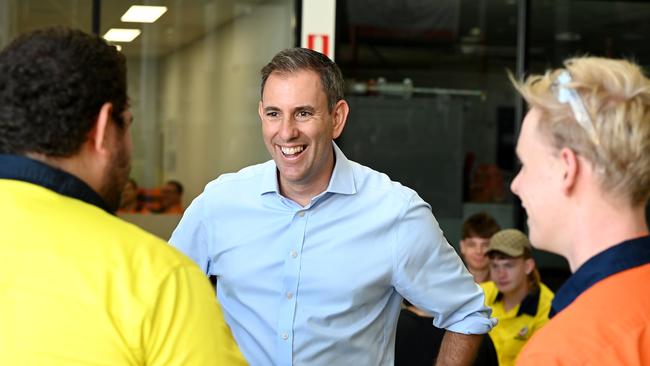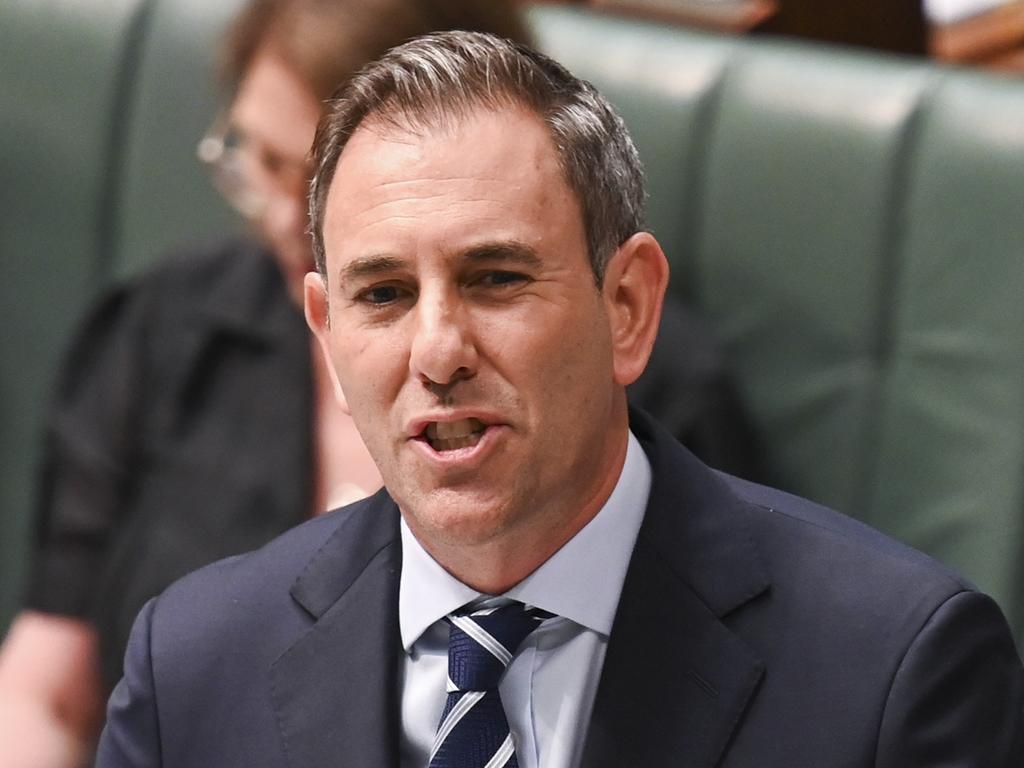Middle class and outer suburbs drive Jim Chalmers’ income tax overhaul
Troy Bramston speaks to the Treasurer about the changes to income tax cuts, who they help, and why the benefit the economy.

It reflected his upbringing in Logan City, outside Brisbane, an area he now represents in parliament where constituents are more likely to be renting or paying off a mortgage than the rest of Australia, and are also younger with a lower median income, looking for relief from cost-of-living pressures while working hard for their families.
The redesign of the stage three income tax cuts, legislated with Labor’s support in opposition, has put those pledges under scrutiny. Chalmers makes no apology for breaking an apparently rock-solid promise. He insists the changes keep faith with his approach to policy and reiterates that all taxpayers will receive a tax cut.

“I think people understand, broadly, that we are trying to do something better for them,” the Treasurer tells Inquirer in an exclusive interview.
“We did change our position. We are very upfront about that. We explained why. And being upfront with people about how and why we think this is a better outcome treats the Australian people with the respect that they expect and deserve.”
The changes mean that from July 1, the 19 per cent income tax rate will reduce to 16 per cent for incomes between $18,200 and $45,000, the 32.5 per cent tax rate falls to 30 per cent for incomes between $45,000 and $135,000, the 37 per cent tax rate would apply from the increased threshold of $135,000 and the 45 per cent tax rate applies to incomes above $190,000.
The result, Chalmers emphasises, is that all 13.6 million taxpayers will receive a tax cut and 84 per cent will be better off compared to the original design that was legislated by the previous Coalition government.
Of course, those on incomes above $146,400 – about 1.1 million taxpayers – will see their benefit reduced and redistributed to those on lower incomes.

And those on high incomes will see their gains halved.
Among the biggest winners, according to Treasury and revealed exclusively by The Australian, are those in the care economy, with 97 per cent of aged and disabled carers, childcare workers and nurses receiving a bigger tax cut.
More than nine in 10 blue collar workers such as labourers, mechanics and police officers will also get a bigger tax cut, and so too will service industry workers in retail and hospitality. The tax cuts have been redesigned to address cost-of-living pressures, including higher petrol and grocery prices, increased rents and mortgage payments, and power bills.
Chalmers points to cheaper medicines, childcare and energy bill relief but concedes that more needed to be done.
“It became increasingly clear to us over summer that we needed to do something much more substantial, that it needed to be broader – so less targeted than some of those measures, but it still needed to not put upward pressure on inflation,” he explains.
“So, once you set those three criteria – bigger, broader, non-inflationary – then the policy logic of this change becomes very clear and very compelling.”
Not all voters will thank the government for breaking a firm election promise, even though Newspoll showed strong overall voter support for the changes. The risk is that repeated assurances not to curb negative gearing, alter the taxing of trusts or implement wealth taxes will be met with scepticism by some voters.
But the opposition has let the government off the hook by promising not to oppose the tax changes in the parliament. This means Peter Dutton’s opposition will be voting to change its own legislated policy in government, despite promising to initially fight the changes and urging a snap election to let voters decide. How can they credibly criticise the government when they are voting for these revised tax changes?
I put it to Chalmers that there was another way: maintaining the original stage three tax cuts but providing further relief for those on low and middle incomes funded by further budget repair and likely higher revenues.
This need not be inflationary but would assist those struggling most with high prices at the supermarket and petrol pump, rents and mortgages.
“We have already found something like $50 billion in savings over two budgets,” the Treasurer responds.
“Reprioritisation of the budget continues, happens in every budget, and we do not downplay that. But the magnitude of the cuts that would have been necessary to do what you are suggesting, I think, rules that out. And so, the most responsible thing to do is to make it revenue neutral.”
This is now the challenge for the Coalition, pledged to maintain the revised stage three tax cuts and also deliver further relief: how do they pay for it?
The original stage three tax cuts provided for what Chalmers terms “top down relief”. Measures in his first two budgets in 2022 and 2023 were what he terms “bottom up relief”. Now, with these changes, the relief is “middle out”.
This is how the Treasurer argues he is delivering for the middle class with a centrist approach to economic policy.
“In order to be a good government and a successful Labor Party, we need to recognise that Labor is the party of Middle Australia, the party of the suburbs and regional towns, and when you think about the distribution of the benefits, there is a tax cut for everyone,” Chalmers says.
“It goes right up and down the income scale, and that is important. There is a real emphasis on Middle Australia, and that is deliberate. It is deliberate in economic terms, overwhelmingly, but it is also consistent with the type of political party that we know we need to be in order to be a long-term government.”
Since the 1970s, the Labor Party has struggled to reconcile a bifurcated constituency – voters on lower and middle incomes in the suburbs and regions with a school education and trade certificate and those voters who are wealthy, often university educated, living in the inner cities, and largely motivated by post-materialist concerns. This is encapsulated in the Treasurer’s outer suburban Brisbane seat of Rankin and the Prime Minister’s inner city Sydney seat of Grayndler.
“The reason this has attracted such broad appeal is because it is a tax cut for every taxpayer, relief right up and down the income scale, and we are still shifting up the top tax threshold,” Chalmers says.
“But the bigger emphasis on working families, the bigger emphasis on young people, the bigger emphasis on suburbs and regions is what shows the Australian people that we can unite the various constituencies.”
Inquirer can reveal further Treasury analysis that shows the biggest beneficiaries of the tax changes are Generation Z (those aged 15-29), earning on average $65,000 per annum, with 96 per cent of these three million-plus taxpayers getting a larger tax cut.
And millennials (aged 30-44) will receive the biggest share of the total benefits (38.9 per cent). “The biggest winners are concentrated in Middle Australia – working families, younger people, the care economy, blue collar workers and the services sector,” Chalmers says.
“This is really what constitutes the future of Middle Australia in industries clustered around our suburbs and regional towns.”
Behind closed doors, some Labor MPs expressed concern this was a redistributive approach, taking benefits from one group and giving them to another, which could be characterised as class warfare. Indeed, 1.1 million taxpayers earning above $146,400 per annum have seen their legislated gains shrink.
“It is completely and absolutely the opposite,” the Treasurer responds.
“The reason for that is because we very deliberately made sure that every taxpayer gets a tax cut. You still, if you are on a higher income, get a decent tax cut. But we have also made sure people under $45,000 get a tax cut. And this is very deliberate. It is deliberate in economic terms, primarily, but it is also an important signal to the Australian people that we understand everyone is under pressure and we are trying to bring people together.
“This is us governing from the centre. This is establishing us as the party of Middle Australia. The suburbs and Middle Australia have always been our north star.
“I said to the caucus that we are at our best when we are the party of Middle Australia, when we are focused on the people who work hard and want to provide for their loved ones and get ahead. And that is what this is all about.”
The government will collect an extra $28 billion in bracket creep – rising incomes forcing workers into higher tax brackets – over the next decade. ANU modelling shows almost one in four workers will be paying more tax than they would have under the original design over the decade.
“There is more than one way to return bracket creep,” Chalmers says.
“The more effective, more efficient, way to return bracket creep is to people on low and middle incomes because that is where bracket creep does the most damage.”
Paul Keating, as treasurer and prime minister, reduced the top marginal income tax rate from 60 per cent to 47 per cent.
Keating has said the top marginal rate, now at 45 per cent plus the 2 per cent Medicare levy, is too high and should be no higher than 40 per cent.
Former ACTU secretary Bill Kelty agrees.
The Treasurer will not be drawn on any plans to reduce the top marginal income tax rate over the next decade. He does not have a rate or a threshold or a timetable in mind and is eager not to imply that he has.
He cryptically adds: “Nobody should assume necessarily that the rates and thresholds that we announced at the beginning of 2024 will be the rates and thresholds that exist in a decade’s time.”
These changes could have been the springboard for broader reform such as increasing the GST and using the revenue to reduce state payroll tax and stamp duties, or providing further income tax relief.
Chalmers insists his tax agenda is bold and ambitious, pointing to changes to the Petroleum Resource Rent Tax, superannuation, multinationals, energy efficiency and electric vehicle incentives, the build-to-rent housing scheme, and cracking down on compliance and the black economy.
He likened floating the dollar to riding a 60-foot wave at Waimea Bay, out on the edge of a surfboard, and not knowing whether you would make it safely to shore.
So, is Chalmers riding the Waimea wave yet?
“That was a characteristically colourful way of describing the ambition that we need and that we have, when it comes to our economy,” the Treasurer says.
“We have only been here for, effectively, half a term but if you think about the reform agenda that we have got under way, you know, we have got all the institutional reform – the Reserve Bank, the Productivity Commission, the Future Fund. We have got all of the budget repair, a surplus already, and another one in prospect. And we have got all the tax reform.
“One of the things I love about Paul, and one of the things I love about our movement and our supporters, is that when it comes to economic reform, they want us to go further and faster. I get that and I think that is a good instinct to have.
“The point that I would make is there is a lot of economic reform under way.”








When Jim Chalmers became Treasurer, he promised to deliver an economic policy focused on the middle class and the suburbs, a centrist approach that eschewed class warfare and the politics of envy and reflected Labor’s nobler goals of supporting aspiration by providing opportunity and reward for effort.